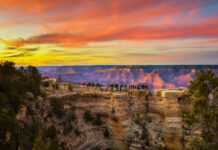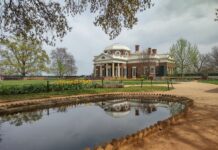 At Zion Lutheran Church in downtown Baltimore, just across from City Hall, a quiet courtyard of boxwood, magnolia, crape myrtle and fig beckons office workers to stop in and take a break. It’s an enclosed green space, free to anyone who wanders by. But at the back wall, under a brick archway, is the real treasure: a fan-shaped biblical tableau, 12-feet-by-12 feet, made up of hundreds of brilliantly colored handcrafted tiles by Henry Chapman Mercer, a visionary of the American Arts and Crafts movement.
At Zion Lutheran Church in downtown Baltimore, just across from City Hall, a quiet courtyard of boxwood, magnolia, crape myrtle and fig beckons office workers to stop in and take a break. It’s an enclosed green space, free to anyone who wanders by. But at the back wall, under a brick archway, is the real treasure: a fan-shaped biblical tableau, 12-feet-by-12 feet, made up of hundreds of brilliantly colored handcrafted tiles by Henry Chapman Mercer, a visionary of the American Arts and Crafts movement.
The Arts and Crafts movement, with its rejection of the mass production of the Industrial Revolution and the fussiness of Victorian decoration, appealed to Mercer, who was born in Doylestown, Pa., just outside Philadelphia, in 1856. He graduated from Harvard in 1879 and trained as a lawyer at the University of Pennsylvania. But he never practiced law; his heart belonged elsewhere. Following the Arts and Crafts precepts of the day, Mercer simply taught himself to do everything he wanted to do, pursuits that included archaeology, architecture and tile making.
 After traveling through Europe, the Middle East and Latin America, collecting clay tiles and other handmade objects along the way, Mercer returned to Doylestown and set about building three structures: Fonthill, the Mercer Museum and the Moravian Pottery and Tile Works. All three exhibit Mercer’s skill with molded concrete and his love of, if not obsession with, tiles. This year marks the 100th anniversary of the completion of Fonthill, a fairy tale castle if ever there were one.
After traveling through Europe, the Middle East and Latin America, collecting clay tiles and other handmade objects along the way, Mercer returned to Doylestown and set about building three structures: Fonthill, the Mercer Museum and the Moravian Pottery and Tile Works. All three exhibit Mercer’s skill with molded concrete and his love of, if not obsession with, tiles. This year marks the 100th anniversary of the completion of Fonthill, a fairy tale castle if ever there were one.
I’ve seen French castles and Bavarian castles— I’ve even seen American castles— but I’ve never seen anything quite like Fonthill. Driving through the charming little city of Doylestown doesn’t prepare one for the sudden appearance of a monumental edifice, set on 60 acres of grass and trees, that looks like an estate out of “Masterpiece Theatre,” albeit a wacky one.
Mercer built Fonthill bit by bit, as he went along, with no defined plan other than the fantasies of his imagination. He had been impressed by Versailles, Herrenchiemsee and Neuschwanstein, and he wanted a castle of his own. He also wanted it to be fireproof. So he built Fonthill entirely of reinforced concrete. He even held bonfires on the top story when it was completed, to prove its mettle.
But if the outside of Fonthill is impressive, the inside is breathtaking. I hang out in the conservatory, where I get just a taste of what awaits in the rest of the house. Tiles. Tiles everywhere. Pressed tiles, mosaic tiles, brocade tiles, tiles that tell tales from the Bible and folklore, tiles of Mayan faces and Viking ships, tiles of the sun and moon and constellations, tiles that depict workshops and wars and weddings, tiles that look like bunches of grapes you could pluck from the ceiling and eat.
And there are still 43 rooms to go! Along with 18 fireplaces, 32 stairwells, 200 windows, and nooks, alcoves, balconies and vaulted ceilings worthy of a Gothic cathedral. You need a guide to get through this place, or they might find your desiccated body in a few months. Luckily, I’ve got Bucks County Historical Society Site Administrator Edward Reidell, who seems to know every one of Mercer’s tiles, along with the 1,500 foreign ones as well— Persian, Chinese, Babylonian, Italian, Dutch, Spanish.
 “Mercer was decades ahead of his time,” says Reidell. “His interest was in the common man and his handiwork.” That’s why he collected as many plain, pressed tiles as highly polished, ornate ones. That’s also why he collected books and artifacts that predated the Industrial Revolution. So many, that he needed yet another place to house them.
“Mercer was decades ahead of his time,” says Reidell. “His interest was in the common man and his handiwork.” That’s why he collected as many plain, pressed tiles as highly polished, ornate ones. That’s also why he collected books and artifacts that predated the Industrial Revolution. So many, that he needed yet another place to house them.
I walk a few blocks to the Mercer Museum, a seven-story wonderland of Old World tools and implements stacked everywhere— and I do mean everywhere— with little winding stone staircases that take you from one room full of surprises to another. Kids will love it, though you might lose them along the way! There’s so much stuff here, I think I must be in a hoarder’s paradise (or hell). Sleds, saws, looms, rakes, boats, bicycles, wooden cigar store statues, even a vampire-killing kit— it’s all too weird and wonderful to believe. I’d like to look at everything, but it’s overwhelming. Besides, I want to leave time to see Mercer’s third testament to the Arts and Crafts movement: the Moravian Pottery and Tile Works.
This National Historic Landmark, a castle-like companion to Fonthill, is a functioning factory where you can see ceramists in action, still molding, glazing and firing tiles from Mercer’s original designs. (The name “Moravian” was Mercer’s tribute to the German heritage of tile craftsmanship in Pennsylvania.) Tours are offered every half-hour, and the ceramists are happy to explain what they’re doing and answer questions. The gift shop contains hundreds of decorative tiles, mosaics, pavers and borders. I can’t resist the noble “Rampant Lion” and a couple of Fleur-de-Lis. And then I see a little crab, blue on a terra cotta background, and have to have it. At 15 bucks each, they’re a bargain as well as a small contribution to keeping this glorious place alive. (A catalog is also offered online.)
 Mercer never married— “he was too eccentric,” Reidell had told me. He lived at Fonthill until his death in 1930, at the age of 73. But his tiles can be found all over the world, from the Pennsylvania State Capitol Building in Harrisburg to the Isabella Steward Gardner Museum in Boston to Grauman’s Chinese Theatre in Hollywood— even the casino at Monte Carlo. And, of course, at Zion Lutheran Church in Baltimore.
Mercer never married— “he was too eccentric,” Reidell had told me. He lived at Fonthill until his death in 1930, at the age of 73. But his tiles can be found all over the world, from the Pennsylvania State Capitol Building in Harrisburg to the Isabella Steward Gardner Museum in Boston to Grauman’s Chinese Theatre in Hollywood— even the casino at Monte Carlo. And, of course, at Zion Lutheran Church in Baltimore.
Fonthill Castle and Mercer Museum / 215-345-0210, http://www.mercermuseum.org
Moravian Pottery and Tile Works / 215-348-6098, http://www.buckscounty.org/departments/tileworks
Doylestown Tourism / www.visitbuckscounty.com




